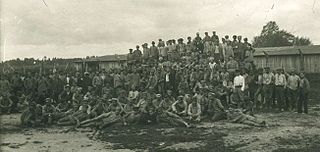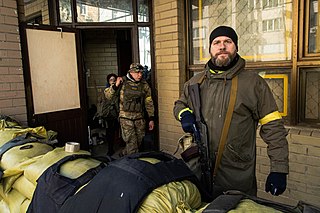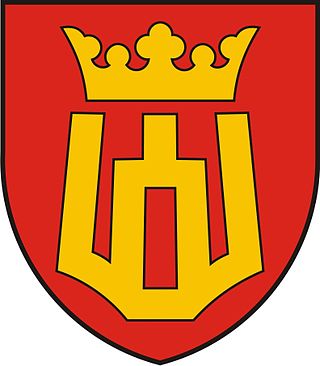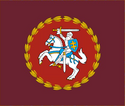
The Lithuanian Armed Forces are the military of Lithuania. The Lithuanian Armed Forces consist of the Lithuanian Land Forces, the Lithuanian Naval Force, the Lithuanian Air Force and the Lithuanian Special Operations Force. In wartime, the Lithuanian State Border Guard Service becomes part of the Lithuanian Armed Forces. A special security department handles VIP protection and communications security.

The Army Reserve is the active-duty volunteer reserve force of the British Army. It is separate from the Regular Reserve whose members are ex-Regular personnel who retain a statutory liability for service. The Army Reserve was known as the Territorial Force from 1908 to 1921, the Territorial Army (TA) from 1921 to 1967, the Territorial and Army Volunteer Reserve (TAVR) from 1967 to 1979, and again the Territorial Army (TA) from 1979 to 2014.

Samogitia or Žemaitija is one of the five cultural regions of Lithuania and formerly one of the two core administrative divisions of the Grand Duchy of Lithuania alongside Lithuania proper. Žemaitija is located in northwestern Lithuania. Its largest city is Telšiai, while Šiauliai, where Aukštaitian dialect is being spoken, is sometimes also included into Samogitia. Samogitia has a long and distinct cultural history, reflected in the existence of the Samogitian language.

The Lithuanian Wars of Independence, also known as the Freedom Struggles, refer to three wars Lithuania fought defending its independence at the end of World War I: with Bolshevik forces, Bermontians, and Poland. The wars delayed international recognition of independent Lithuania and the formation of civil institutions.

Mechanized Infantry Brigade "Iron Wolf" is the core unit of the Lithuanian Army and forms the country's contribution to NATO collective defence. The name of the brigade relates to the Lithuanian mythical character from the medieval foundation legend of the Vilnius city.
The Lithuanian Territorial Defense Force was a short-lived Lithuanian volunteer military unit created with the active involvement of the anti-Nazi Lithuanian resistance during the German occupation of Lithuania during World War II. The LTDF was disbanded one and a half months after its creation by its commander Povilas Plechavičius when Nazi Germany's occupational authorities threatened the unit's independence. During the subsequent repressions, the German occupiers sent 52 officers to the Salaspils concentration camp, executed 86 LTDF members in Paneriai and deported 1,089 to Stutthof and Oldenburg concentration camps. While some were later forced into Nazi service, all except four of the force's fourteen battalions successfully escaped Nazi persecution. Those who escaped later contributed to the Forest Brothers' armed anti-Soviet resistance.

The Bulgarian Land Forces are the ground warfare branch of the Bulgarian Armed Forces. It is administered by the Ministry of Defence, previously known as the Ministry of War during the Kingdom of Bulgaria. The Land Forces were established in 1878, when they were composed of anti-Ottoman militia (opalchentsi) and were the only branch of the Bulgarian military.

The Lithuanian–Soviet War or Lithuanian–Bolshevik War was fought between newly independent Lithuania and the Russian Socialist Federative Soviet Republic in the aftermath of World War I. It was part of the larger Soviet westward offensive of 1918–1919. The offensive followed the retreat of German troops and sought to establish Soviet republics in Ukraine, Belarus, Lithuania, Latvia, Estonia, Poland and link up with the German Revolution. By the end of December 1918 Soviet forces reached Lithuanian borders. Largely unopposed, they occupied one town after another and by the end of January 1919 controlled about two thirds of the Lithuanian territory. In February, the Soviet advance was stopped by Lithuanian and German volunteers, who prevented the Soviets from capturing Kaunas, the temporary capital of Lithuania. From April 1919, the Lithuanian war went parallel with the Polish–Soviet War. Poland had territorial claims over Lithuania, especially the Vilnius Region; these tensions spilt over into the Polish–Lithuanian War.

The National Defence Volunteer Forces or NDVF is a branch of the Lithuanian Armed Forces. Volunteer forces were officially established on 17 January 1991 by the law of the Supreme Council of Lithuania on the National Defence Volunteer Service providing basis for establishing Voluntary National Defence Service. This decision made legal already existing volunteer formations that began appearing as early as 1990. Voluntary National Defence Service was reorganised into the National Defence Volunteer Force. In 2003 Volunteer Force was integrated into the Lithuanian Land Force. Tasks of volunteer soldiers were inevitably altered when Lithuania became a full-fledged member of NATO: approach of territorial defence was changed into territorial defence and training of modern active reserve. There are around 5000 volunteers and around 800 professional soldiers in the force.

Lieutenant General Arvydas Pocius is a former Chief of Defence of Lithuania. During his military career, Pocius has held various positions, including Chief of Staff of Voluntary Service of National Defence, and Commander of the Lithuanian Land Force. Pocius was Lithuanian champion of freestyle wrestling in junior, youth and adult groups.

The Territorial Defence Force – TDF is the fifth military branch of the Polish Armed Forces, following Land Forces, Air Force, Navy and Special Forces. The force is made up of professional and part-time volunteer soldiers, forming part of the country's defence and deterrence system. Formed in 2016, it had reached 24,000 personnel by July 2019, and was slated to reach a size of around 53,000 personnel in 17 light infantry brigades by 2021. The creation of the Polish TDF relates to the reforms in the Baltic states' Territorial Defence Forces to provide response during the early stages of a hybrid conflict.

Enhanced Forward Presence (EFP) is a NATO-allied forward-deployed defense and deterrence military force in Northern, Central and Eastern Europe. This posture in Northern Europe through Estonia, Latvia, and Lithuania and in Central Europe through Poland, Slovakia and Hungary and in Eastern Europe through Romania and Bulgaria, is in place to protect and reassure the security of NATO's Northern, Central and Eastern European member states on NATO's eastern flank.

Vincas Vitkauskas was a Lithuanian general. He became commander of the Lithuanian Army after the resignation of Stasys Raštikis in January 1940. In this capacity, Vitkauskas opposed armed resistance to the Soviet occupation in June 1940 and subsequently collaborated with the new Soviet regime.

The Territorial Defence Forces are the military reserve component of the Armed Forces of Ukraine.

The Grand Duke Gediminas StaffBattalion is a unit of the Lithuanian Armed Forces, whose staff it protects. It is also charged with representing Lithuania and its army by providing guard of honour at official events in Lithuania and abroad.

The Lithuanian Land Forces Band also informally known as the Iron Wolf Military Band, is a Lithuanian military band that serves as the official band of the Lithuanian Land Forces. It is officially attached to the Mechanised Infantry Brigade Iron Wolf, specifically the Grand Duchess Birutė Mechanized Uhlan Battalion in Alytus. It was established in the half of 1994. It is currently composed of 36 members of the land forces. It has taken part in many international festivals since it came into existence around the time of the Fall of the Soviet Union. Among these festivals are the Hamina Tattoo in 2008. It has also taken part in many municipal and regional events. Notable commanders also include General Justinas Jonušas and Captain Viktoras Ščetilnikovas, who served the band until his death in 2019.

The Lithuanian Naval Force Band is an official military band in the Lithuanian Armed Forces. The band has been in existence since 1966, back when Lithuania was still known as the Lithuanian SSR in the Soviet Union. In Soviet times it was a professional Klaipėda City Orchestra. Justin Jonuš was appointed as the first conductor at that time. In 1971, 1974 and 1977 the orchestra won the 2nd place in the LSSR's music competitions, and the 1st place in competitions of the same nature in 1979, 1980 and 1983. The band has been part of the National Defense System since 1 May 1998. It began its service in the Lithuanian Armed Forces as part of the 7th Grand Duke Butigeidis Coast Dragoon Battalion of the Lithuanian Land Force. In 2000, the band was transferred to the composition of the Žemaitija Motorized Infantry Brigade in Klaipėda, which was itself later reorganized into the Western Military District. On 1 July 2004, the military reassigned the band to the Lithuanian Naval Forces.

Jonas Semaška, nom de guerreLiepa, Rikis, Gaučas was a Lithuanian officer of the Lithuanian Army, the Red Army's 29th Rifle Corps and then the Lithuanian Auxiliary Police Battalions formed by Nazi Germany. Semaška was a leader of Lithuanian partisans, who fought for Lithuanian independence.
The National coat of arms of Lithuania is a mounted armoured knight holding a sword and shield, known as Vytis. Since the early 15th century, it has been Lithuania's official coat of arms and is one of the oldest European coats of arms. The coat of arms features a red field with a white (silver) armoured knight on a white (silver) horse holding in his right hand a white (silver) sword above his head.

Stasys Nastopka was a Lithuanian military officer during World War I and the Lithuanian Wars of Independence.


























